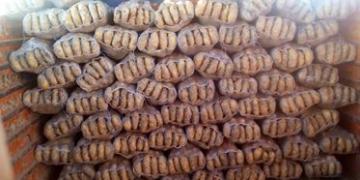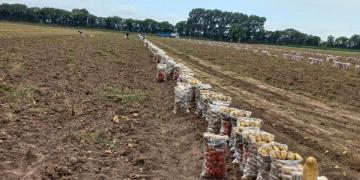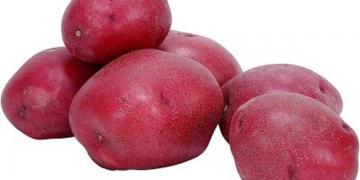The Humble Potato Is Exalted in the Mountains of Peru
Chahuaytire, Peru — Gumercinda Quispe is a descendant of Peruvian Incas and here, high in the Andes, more than 12,500 feet above sea level, she has prepared a nourishing, spicy potato soup, quacha chuño.

She has made it with both fresh potatoes and chuño, the dried, hard white potatoes that are still prepared just a stone’s throw away. The ancient preservation process includes soaking them in an icy stream, stomping them by foot to remove the skins and drying them in the sun.
I love potatoes. They are not a staple in my native India, as they are in Peru. In India, they are a beloved, cheap treat. Cooked in thousands of different ways, almost always creatively burnished with selective spoonfuls from a treasure chest of seasonings and spices, potatoes are served in every town and village at mealtimes and as chutney-augmented street snacks. I wanted to learn more about potatoes here in the land of their birth.
In the little mountain village of Chahuaytire near the town of Pisac in southern Peru, Ms. Quispe and I sat down at a table close to the warm, sooty hearth in the rustic restaurant where she works. The sun was shining bright outside, and the sky was a clear, cold blue.
“Put some sauce in the soup and drink from the bowl,” she said, motioning to the verdant uchucuta sauce she had prepared. “Uchu” means “chiles” in the Quechua language of the Incas, and “cuta” means “ground.”
PhotoPastel de papa, a potato cake layered with bacon and cheese, at the Sumaq Hotel.CreditGuillermo Gutierrez Carrascal for The New York TimesThe sauce, a mouth-smackingly good fresh chutney to this Indian, is not just hot from one of the dozens of chiles native to Peru, but sour from limes that came with the Spaniards, and deeply aromatic from huacatay and other wild herbs that grow in the mountains.
There was a time when Incas used only wild Peruvian herbs, but today, after centuries of Spanish influence, they go to the market and buy an asnapa, a bouquet of herbs that could include the New World huacatay but also gifts from the Old World like cilantro, mint, oregano, parsley and tarragon.
Potatoes come in every texture and color. You can see them in the markets: reds, blues, purples, yellows and pinks, sometimes ringed with two colors when sliced open. The texture of some varieties can be changed by putting them out in the sun for a few days before cooking them. This turns them softer and silkier.
Some are shaped like a puma’s paw; others, an alpaca’s nose or a cat’s claw. Native to the Andes in Peru and northwest Bolivia, potatoes were domesticated more than 10,000 years ago. And yet new varieties are being discovered all the time.
Potato banks — like the one in the Pisac region of the Andes that stores seeds in a climate-controlled vault for 1,300 varieties of potatoes — are always searching for new varieties, as are dozens of creative Peruvian chefs on the lookout for wild and unusual indigenous ingredients.
Freeze-drying the potato for chuño was just one method used to increase its life after harvest. Running or walking was the chief mode of transportation for most ancient Andean peoples (certainly the Incas); they could easily carry dried potatoes with them and make a quick stew with local herbs, chiles and water from a mountain stream whenever hunger called.
Dried potatoes in Peru come in many forms. They can look like pebbles — hard and smooth, in white or purple. They can look like large gravel, with different colors. But they can also be soft, tasting and smelling as funky as fermented bean curd or ripe cheese. Each has a different flavor and texture.
The Inca guide who traveled with me through the Andes still hikes carrying dried potatoes (sometimes in a powdered form) and llama jerky, essential ingredients for a soup he considers a part of his cultural inheritance.
Potatoes were given superb treatment wherever I traveled. At the Sumaq Hotel in the town of Aguas Calientes, there was pastel de papa, a meltingly soft potato cake with layers of thin-sliced potato, bacon and cheese.
Papa a la Huancaina, which originated in the town of Huancayo in the central highlands and is considered by many to be Peru’s national dish, was everywhere, including the cafeteria at Machu Picchu. Boiled, sliced potatoes and boiled, sliced eggs were placed on top of lettuce leaves with some olives strewn about, and dressed with a Huancaina sauce that brought the dish together. Its main ingredient was the long, aromatic orange chile, aji amarillo.
Perhaps my favorite dish of all was causa. Like lasagnas, causas are layered terrinelike dishes, generally served cold, though room temperature can also work for some of them.
Instead of pasta, potatoes — mashed and seasoned with an aji amarillo paste, lime juice, olive oil and salt — are the most important element in a causa. They can provide one, two or even three of the layers in the dish. The other in-between layers could include seafood salad, vegetable salad, chicken salad or, as in the Amazon region, pork-and-onion salad made with the addition of the fiery, round charapita chile.
Whichever way it is served, causa is always soothing — and refreshingly delicious. For the hotter regions of Peru, it is just as cooling and satisfying as that warming soup is in the Andean mountains.
Fuente: https://www.nytimes.com/2018/04/16/dining/potatoes-peru-madhur-jaffrey.html?ref=nyt-es&mcid=nyt-es&subid=article






